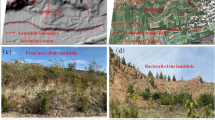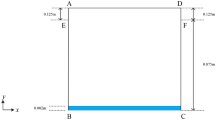Abstract
The problem of the wedging of an elastic body by a slender wedge moving with a speed between that of Rayleigh surface waves and the velocity of transverse elastic waves is considered.
It is shown that at a super-Rayleigh velocity of wedge motion the statement of the elastic problems becomes different in comparison with the sub-Rayleigh case: no free crack is formed ahead of the wedge, the contact of the wedged body is maintained at the wedge head surface only. At some distance from the leading edge of the wedge the wedged body separates from the wedge surface and the elastic body surface behind the separation point becomes free from stress. There occurs in this case “free-streamline flow” of the wedged elastic body around the wedge which is accompanied, in contrast with sub-Rayleigh case, with the radiation of energy from the wedge head to the infinity. Appearance of compressive stresses ahead of the wedge, also in contrast with the sub-Rayleigh case suggests that the nature of the wedged body fracture changes with the transition of the wedge velocity from a sub-Rayleigh to a super-Rayleigh one.
Résumé
On étudie le problème de l'entaillage en coin d'un corps élastique par un coin effilé pénétrant dans un corps élastique à une vitesse comprise entre celle des ondes de surface de Rayleigh et celle des ondes élastiques transversales.
On montre que aux vitesses supérieures à celies de Rayleigh, les problèmes élastiques s'abordent différemment qu'avec des vitesses inférieures à celies de Rayleigh: il tie se forme pas de fissure libre en avant de l'entaille, et le contact entre le coin et le corps entaillé tie s'établit qu'à la surface de l'extrémité du coin.
À une certaine distance de celle-ci, le corps entaillé n'est plus en contact avec la surface du coin. La surface du solide au delá du point de contact se révéle libre de tensions.
Il se produit dans ce cas une sorte d'écoulement en courant naturel du corps élastique le long du coin, accompagné d'une diffusion d'énergie depuis l'extrémité du coin jusqu'à l'infini. Cette derniére manifestation est à mettre en contraste par rapport an cas des vitesses inférieures à celies des ondes de Rayleigh.
Il en est de même de l'apparition de contraintes de compression en avant de l'entaille. Celle-ci suggère que le type de rupture du corps entaillé se modifie lorsque l'on passe d'une vitesse inférieure à une vitesse supérieure à celle des ondes de Rayleigh.
Zusammenfassung
Man untersucht das Problem der Einkerbung eines elastischen Körpers durch Eindringen cities spitzen Domes bei Eindringgeschwindigkeiten welche zwischen denjenigen der Oberflächenwellen von Rayleigh und denen der transversalen Wellen liegen.
Es wird gezeigt, daß bei Geschwindigkeiten oberhalb denjenigen der Rayleigh-Wellen die elastischen Probleme anders behandelt werden müssen als bei Geschwindigkeiten unterhalb denen von Rayleigh. Vor der Einkerbung bildet sich keinRiß, und der Kontakt zwischen dem elastischen Körper und dem eindringenden Dorn findet erst an der Dornspitze statt. In einer gewissen Entfernung dieser Spitze besteht keine Berührung mehr mit dem Körper und die Körperoberfläche wird frei von Spannungen.
Es ergibt sich in diesem Falle von “freiem Stromlinienfluß” längs dem Dorn welcher von einer Energiediffusion von der Dornspitze his ins Unendliche begleitet ist. Letztere Erscheinung steht im Gegensatz zum Verhalten bei Geschwindigkeiten unterhalb denjenigen der Rayleigh-Wellen.
Das Auftreten von Kompressionsspannungen vor der Dornspitze, welches ebenfalls im Gegensatz zum Falle von Sub-Rayleigh-Wellen steht, weist darauf hin, daß sich das Bruchverhalten des Körpers verändert, wenn die Eindringgeschwindigkeit des Domes von einem Wert unterhalb der Geschwindigkeit der Rayleigh-Wellen auf einen Wert oberhalb übergeht.
Similar content being viewed by others
References
G. I. Barenblatt, N. N. Vsevolodov, L. I. Mirkin, N. F. Pilipetsky, Yu. P. Raiser, Destruction of transparent materials under the action of laser radiation. Appearance of gas bubbles and wedging of the material by gas pressure. ZhETP Letters, 5, 3 (1967).
S. Winkler, D. A. Shockey, D. R. Curran, Crack propagation at supersonic velocities. I. Int. J. Fracture Mechanics, 6, 2 (1970).
G. I. Barenblatt, S. A. Khristianovich, On the collapse of roofing for mine shafts. Izvestia Akad. Nauk SSSR, OTN, 11 (1955) (in Russian).
G. I. Barenblatt, On equilibrium cracks forming during brittle fracture. Rectilinear cracks in flat plates, PMM, 23, 4 (1959).
G. I. Barenblatt, G. P. Cherepanov, On the wedging of brittle bodies, PMM, 24, 4 (1960).
L. A. Galin, Mixed problems of elasticity theory with friction forces for a half-plane. Doklady Akad. Nauk, 39, 43 (1943).
I. N. Sneddon, Stress producted by a pulse of pressure moving along the surface of a semi-infinite solid. Rendiconti Circolo mat. Palermo, 1 (1952) 57.
I. N. Sneddon, D. S. Berri, The classical theory of elasticity. In Encyclopedia of physics, S. Flügge, ed., Vol. 6, Springer-Verlag, Berlin-Göttingen-Heidelberg, 1958.
J. R. Willis, A comparison of the fracture criteria of Griffith and Barenblatt, J. Mech. Phys. Solids, 15, 3 (1967).
J. N. Goodier, F. A. Field, Plastic energy dissipation in crack propagation. In Fracture of Solids, Interscience, N.Y.-L., (1963) 103–118.
T. Yokobori, A. Kamei, A note on the extension of plastic zone in the direction of the path of the moving brittle crack, Reports of Research Institute for Strength and fracture of materials, Tohuku University, Sendai, Japan, 2, 2 (1966).
C. Atkinson, A simple model of a relaxed expanding crack. Arkiv for Fysik, 35, 38 (1968).
C. Atkinson, A note on some simple models of a relaxed expanding crack (in press).
A. H. Cottrell, Mechanics of fracture in large structures. Proc. Roy. Soc., A285, 1400 (1965).
Author information
Authors and Affiliations
Rights and permissions
About this article
Cite this article
Barenblatt, G.I., Goldstein, R.V. Wedging of an elastic body by a slender wedge moving with a constant super-Rayleigh subsonic velocity. Int J Fract 8, 427–434 (1972). https://doi.org/10.1007/BF00191104
Received:
Issue Date:
DOI: https://doi.org/10.1007/BF00191104




